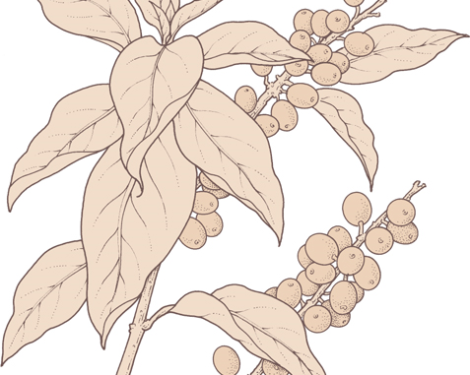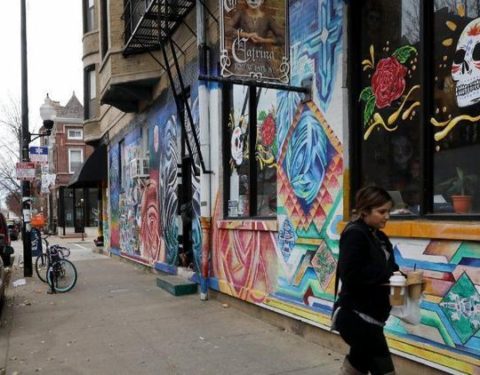Coffee is one of the world’s most valuable traded natural commodities, second only to oil, and it is produced and consumed worldwide. The prized bean is believed to have originally evolved in the wild in East Africa, but global exploration introduced it to many different cultures. Today, coffee is cultivated in more than seventy countries in an area known as “the bean belt.”
THE BEGINNINGS OF COFFEE CULTURE
Although the precise origins of the consumption of coffee remain uncertain, it was likely first discovered in Ethiopia. It is thought that at some point before 1000 CE Ethiopian tribes began to grind the coffee fruits containing the coffee seeds or beans and mix them with an animal fat, making a kind of energy bar to sustain them on hunting trips or long journeys. Some nomadic tribes continue to consume these bars even today.
One popular legend has it that coffee’s fortuitous introduction to the human race came about when a young Ethiopian goatherd found his goats prancing tirelessly after chewing on an unusual plant. Having sampled some of it himself and feeling energized as a consequence, the goatherd brought some of the magical plant back to his community. Word spread, and the rest is history.
The earliest evidence of human cultivation of the coffee plant has been traced back to the fifteenth century in Yemen. As with accounts of the discovery of coffee, just how it traveled to the Arabian Peninsula is largely a matter of conjecture. Some stories tell of Sudanese slaves chewing on coffee fruits to help them survive the journey from Ethiopia to Arabia; some tell of an Islamic scholar observing the invigorating effects of coffee on a trip to Ethiopia and bringing it back on his return to the Arabian Peninsula. Yet other tales view the spread of coffee simply as the result of the ongoing trade that existed between the two places.
Whatever the precise course of events, fifteenth-century Sufi monks imbibed coffee as a beverage to help keep them awake during their nighttime prayers. It wasn’t long before the drink became popular with the rest of the population, particularly the Muslims, who for religious reasons were barred from consuming intoxicating beverages, such as alcohol. Coffeehouses, known as kaveh kanes, multiplied throughout the Arab world, becoming communal hubs for socializing, education, and general merriment.
Coffee became known as “Arabian wine” or “wine of Araby,” and tales of this dark, bitter, stimulating beverage returned home with the thousands of pilgrims who visited Mecca every year. Venetian traders first introduced coffee to Europe in 1615, probably bringing the beans from the Middle East into Venice, where coffee soon became a fashionable beverage. By the 1650s, it was sold on the streets of Venice by lemonade vendors, along with liquor and chocolate, and the first European coffeehouse was opened there in the mid-1600s. Believed to have medicinal benefits, coffee was claimed to cure drunkenness, gout, smallpox, and nausea, among other ailments.
HOW COFFEE WENT GLOBAL
While the drinking of coffee spread throughout the Middle East, westward into Europe, and eastward into Persia and India in the sixteenth and early seventeenth centuries, and thereafter to the New World, the Arabs attempted to maintain a monopoly in the coffee trade by closely guarding its cultivation—they would boil or lightly roast coffee seeds before they were exported, to render them infertile. Despite their efforts, coffee cultivation began to extend beyond the Middle East in the seventeenth century, mainly due to the Dutch, who dominated international shipping trade at that time.
Attempts to cultivate coffee plants smuggled from Yemen to Europe in the early seventeenth century failed. However, when the Dutch took control of parts of Ceylon (now Sri Lanka) from the Portuguese in the mid-1600s, they found small coffee plantations begun with plants brought in by Arab traders, which they subsequently developed along with plantations established in their colonies on the Malabar Coast of India. In the late 1690s, they took coffee plants to their colony of Batavia (now Java), which was became their main source of supply. From there, seeds were taken back to the Hortus Botanicus (botanical gardens) in Amsterdam and were successfully cultivated in greenhouses in 1706.
The first botanical description of the coffee tree, Coffea arabica, was made in these gardens by French botanist Antoine de Jussieu in 1713, and today coffee-loving pilgrims can come to the gardens to gaze on plants that have a direct lineage back to the eighteenth century. Their progenitors were to become the source of most of the cultivated coffee plants in the world today.
TURKISH COFFEE BY LAW
Coffee was introduced to Turkey in the late fifteenth century and became an immensely popular beverage—so much so that Turkish law stated that a woman could divorce her husband if he did not provide her with a daily quota of coffee.
On a separate occasion, in 1670, the Sufi mystic Baba Budan reputedly smuggled seven coffee seeds from Yemen to the hills of Chikmagalur in Karnataka in southwest India, which was to become a renowned coffee-growing region.
Meanwhile, coffee’s spread to the West is attributed to the Columbian Exchange: the transfer of plants, animals, ideas, and diseases between the Eastern and Western hemispheres that followed Columbus’s voyage to the New World of the Americas in 1492. Coffee and tea flowed one way, and chocolate in the other direction. The Dutch established coffee cultivation in their South American colony of Dutch Guiana (now Surinam) in the early eighteenth century, and at the same time, the mayor of Amsterdam presented the Sun King of France, Louis XIV, with a coffee plant from the Hortus Botanicus. A cutting from this plant was taken to the French Caribbean colony of Martinique by French naval officer Gabriel Mathieu de Clieu in 1723, and from there coffee spread to other Caribbean islands and to French Guiana. The story goes that coffee plants were smuggled into Brazil in 1727, leading to the beginnings of the world’s largest coffee industry. With a happy circularity, Brazilian coffee plants were transported to Kenya and Tanganyika (now Tanzania) in East Africa in the late nineteenth century, bringing new coffee varietals to the area of the plant’s wild origins in Ethiopia. Ethiopia has since become one of the top ten commercial coffee producers in the world.
In the New World, coffee became popular in Central and South America under the Spanish and Portuguese in the eighteenth century. In the British North American colonies, tea was the drink of choice until 1773, when the settlers rebelled against the heavy duty placed on it by the British government. Following the 1773 Boston Tea Party protest, coffee became the patriotic drink in the Thirteen Colonies that formed the United States following the War of Independence (1775–83).
Today, the vast coffee-cultivation area known as “the bean belt” sits almost entirely within the humid equatorial region between the two tropics, comprising growing regions that have steady temperatures of around 68°F (20°C), rich soil, moderate sunshine, and rain. Many countries, economies, and about twenty-five million people now depend upon coffee cultivation and export.
The world’s top ten coffee-producing countries according to the International Coffee Organization (ICO) are Brazil, Vietnam, Colombia, Indonesia, Ethiopia, India, Mexico, Guatemala, Peru, and Honduras. Brazil produces around one-third of the world’s coffee. Some coffee connoisseurs say that Brazilian growers favor quantity over quality, but this misconception may relate back to a quota that was once placed on producers by the local coffee institute. Introduced in the early 1960s as part of the International Coffee Agreement, the quota system was designed to ensure equitable prices and a stable market. Various sources commented that high-quality beans may have been blended before export to meet weight quotas, resulting in an inferior product, because the different types of bean could not be evenly roasted together. Since the suspension of the quotas in the late 1980s, consumers have been increasingly able to purchase beans from a single estate, and the complexity, quality, and variety of Brazilian beans is now evident. Because most farms in Brazil are small (70 percent are smaller than 25 acres / 10 hectares), the diversity and range of product is vast.
With all these countries producing coffee, as well as the various growing regions within the countries, the options to choose from when selecting coffee can be simply overwhelming, whether as a coffee buyer for a corporate coffeehouse or café or as a consumer. A coffee lover’s only option is to taste, identify personal preferences, and continue to be an analytical consumer. Various soils and terroirs can certainly produce beans with similarities if they are processed in the same way, so it is not just the growing location that dictates the flavor profile of a coffee bean. There are many different influencing factors at every step of the process, from climate conditions before the crop is harvested to the method used to extract that dark, aromatic liquid into your cup. This is why a Starbucks “laboratory” in Amsterdam, for example, runs trials of new advances in coffee, creating and shaping trends that are then rolled out across the Continent. Their buyers taste beans from each estate every year, ordering the best selection from the crops available—while one year an Ethiopian Yirgacheffe might be of exceptional quality, next year the Sumatran Batak may rate more highly on the palates of the demanding coffee critics.
The home barista can become equally adept at coffee sampling with the many opportunities to continually explore the huge range available. That’s the beauty of coffee—there are so many hundreds and thousands of combinations of beans, roasts, grinds, and brewing methods that coffee lovers could spend a lifetime drinking a different cup every day.




